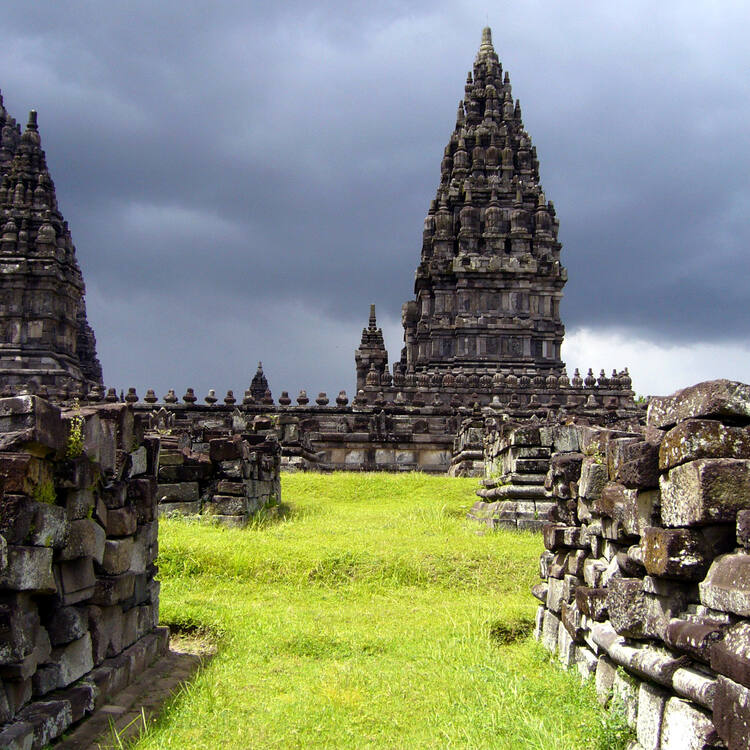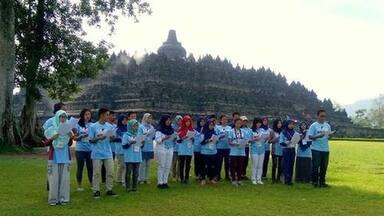Prambanan Temple Compounds
Prambanan Temple Compounds
Built in the 10th century, this is the largest temple compound dedicated to Shiva in Indonesia. Rising above the centre of the last of these concentric squares are three temples decorated with reliefs illustrating the epic of the Ramayana, dedicated to the three great Hindu divinities (Shiva, Vishnu and Brahma) and three temples dedicated to the animals who serve them.
Description is available under license CC-BY-SA IGO 3.0
Ensemble de Prambanan
Construit au Xe siècle, c'est le plus grand ensemble shivaïte d'Indonésie. Au milieu de la dernière des enceintes carrées concentriques s'élèvent les trois temples, décorés de reliefs illustrant l'épopée du Ramayana, dédiés aux trois grandes divinités hindouistes : Shiva, Vishnu et Brahma, et trois temples dédiés aux animaux qui servent de monture à ces dieux.
Description is available under license CC-BY-SA IGO 3.0
مجمّع برامبانان
إنها المجموعة الشيفائية الكبرى في أندونيسيا وقد بنيت في القرن العاشر. ووسط آخر سور مربّع متراكز، ترتفع المعابد الثلاثة مزيّنةً بنقوش عن ملحمة رامايانا، وهي مكرّسة للآلهة الهندوسية الكبرى الثلاثة: شيفا، وفيشنو، وبراهما، وكذلك ثلاثة معابد مكرّسة للحيوانات التي تُستعمل مطيّة لتلك الآلهة.
source: UNESCO/CPE
Description is available under license CC-BY-SA IGO 3.0
普兰巴南寺庙群
建于10世纪的普兰巴南寺庙群是印度尼西亚最大的湿婆神建筑群。六座寺庙在同心广场的正中间拔地而起:其中三座主寺庙饰有罗摩衍那史诗的浮雕,分别供奉着印度教的三位主神(湿婆、毗湿奴和罗摩);另外三座寺庙为守护神灵的动物而建造。
source: UNESCO/CPE
Description is available under license CC-BY-SA IGO 3.0
Храмовый комплекс Прамбанан
Прамбанан, построенный в X в., является крупнейшим в Индонезии храмовым комплексом, посвященным богу Шиве. Над центром верхней из трех концентрических платформ возвышаются три храма, украшенные каменными рельефами на темы эпоса «Рамаяна», посвященные трем великим индийским божествам (Шива, Вишну и Брахма), и три храма – служащим им животным.
source: UNESCO/CPE
Description is available under license CC-BY-SA IGO 3.0
Conjunto de Prambanan
Construido en el siglo X, este conjunto monumental es el más grande de los dedicados al culto de Siva en Indonesia. En medio del último de los recintos cuadrados concéntricos se alzan tres templos consagrados a cada una de las deidades principales del hinduismo: Siva, Visnú y Brahma. Estos santuarios están ornamentados con relieves ilustrativos de la epopeya del Ramayana. Junto a ellos se alzan otros tres templos dedicados a los animales que sirven de montura a esos dioses
source: UNESCO/CPE
Description is available under license CC-BY-SA IGO 3.0
プランバナン寺院遺跡群
ジャワ島中部にあるヒンドゥー教の遺構。シヴァ信仰を中心としたもので、9世紀後期の建築と推定されている。当初は広大な寺院建築群であったと見られているが、現在修復ないし復元されているのは、その中心部の石垣に囲まれた110m四方の区域のみである。主建築として東西の2列に3基ずつの祠堂が並び、その他の小祠堂を含めて、全体がジャワ随一の雄大な規模の建築群であったことを示している。source: NFUAJ
Prambanan tempelcomplex
Het Prambanan tempelcomplex, gebouwd in de 10e eeuw, is het grootste tempelcomplex gewijd aan Shiva in Indonesië. Het bestaat uit de Prambanan tempel (ook wel Loro Jonggrang), Sewu Tempel, Bubrah Tempel en Lumbung Temple. Drie tempels zijn versierd met reliëfs ter illustratie van het epos van de Ramayana en gewijd aan de drie grote hindoe-goden (Shiva, Vishnu en Brahma). De Prambanan tempel zelf bestaat uit 240 tempels. De tempels en hun bijgebouwen vormen samen het Prambanan Archeologisch park, gebouwd tijdens de hoogtijdagen van de machtige dynastie Sailendra in Java, in de 8e eeuw na Christus.
Source: unesco.nl
Outstanding Universal Value
Brief synthesis
Prambanan Temple Compounds consist of Prambanan Temple (also called Loro Jonggrang), Sewu Temple, Bubrah Temple and Lumbung Temple. Prambanan Temple itself is a complex consisting of 240 temples. All the mentioned temples form the Prambanan Archaeological Park and were built during the heyday of Sailendra’s powerful dynasty in Java in the 8th century AD. These compounds are located on the border between the two provinces of Yogyakarta and Central Java on Java Island.
While Loro Jonggrang, dating from the 9th century, is a brilliant example of Hindu religious bas-reliefs, Sewu, with its four pairs of Dwarapala giant statues, is Indonesia’s largest Buddhist complex including the temples of Lumbung, Bubrah and Asu (Gana temple). The Hindu temples are decorated with reliefs illustrating the Indonesian version of the Ramayana epic which are masterpieces of stone carvings. These are surrounded by hundreds of shrines that have been arranged in three parts showing high levels of stone building technology and architecture from the 8th century AD in Java. With over 500 temples, Prambanan Temple Compounds represents not only an architectural and cultural treasure, but also a standing proof of past religious peaceful cohabitation.
Criterion (i): Prambanan Temple Compounds presents the grandiose culture of Siva art as a masterpiece of the classical period in Indonesia, and the region.
Criterion (iv): The property is an outstanding religious complex, characteristic of Siva expression of the 10th century.
Integrity
Prambanan Temple Compounds comprises of two groups of buildings which includes Loro Jonggrang, Sewu complexes, Lumbung, Bubrah and Asu (Gana). The 508 stone temples of various shapes and sizes are either in a complete and preserved condition or have been retained as ruins. This site includes all elements necessary to express its exceptional significance and is well maintained. There are no threats of development or neglect; however the area is prone to natural threats such as earthquakes and volcanic eruptions.
Authenticity
Prambanan Temple Compounds contains the original structures that were built in the 9th century AD. The temples collapsed due to earthquake, volcanic eruption and a shift of political power in the early 11th century, and they were rediscovered in the 17th century. These compounds have never been displaced or changed. Restoration works have been conducted since 1918, both in original traditional method of interlocking stone and modern methods using concrete to strengthen the temple structure. Even though extensive restoration works have been done in the past and as recently as after the 2006 earthquake, great care has been taken to retain the authenticity of the structures.
Protection and management requirements
The property has been designated as a National Cultural Property in 1998 and the national law issued in 2010 also supports the protection and conservation of the property. Management of Prambanan Temple Compounds is accommodated in the Presidential Decree of 1992 that established the 77 ha that encompasses the property under central government ownership. This area is divided into two zones. The management of Zone 1 or the area within the boundary is conducted by the Ministry of Culture and Tourism under two different regional offices, namely the Archaeological Preservation Office of Yogyakarta and Central Java. The Borobudur, Prambanan and Ratu Boko Tourism Park Ltd. are responsible for Zone 2 which comprises the buffer zone. In order to implement standard operations for the safeguarding of the property, the government has established a regulation concerning national vital object area. All regulations have been well enforced and implemented.
In order to improve the management of the property, government issued the law in 2007 and government regulation of 2008 concerning national spatial planning which means that spatial planning in World Cultural Heritage area will be prioritized. Prambanan site has been established as one of the strategic national area which consists of Prambanan temple Compounds and others related temple remains. To ensure the long term safeguarding of the property, an integrated management and regulation that support preservation is needed.
The Action Plan of 2007 has been implemented with the involvement of the local community around the property. The welfare of the local community around the property that was affected by the earthquake of 27 May 2006, is now improving with the recovery of the usual economic activity and especially in the creative industry sector. The Siva temple has not been rehabilitated but research activities or technical studies of the Siva temple have been carried out in 2010 and 2011. The results have been discussed at national and international level with the conclusion that it is still necessary to study and research to determine the method of handling Siva Temple, including monitoring through seismograph study and crack meter periodically.

 View photos from OUR PLACE the World Heritage collection
View photos from OUR PLACE the World Heritage collection

